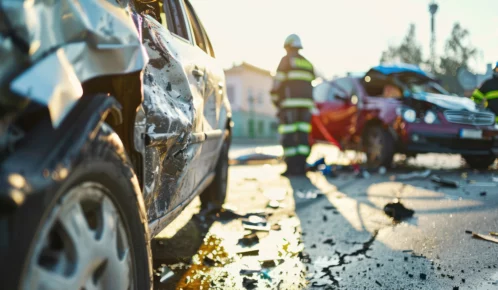Distracted driving is any activity that diverts your attention from driving. There are 3 types of distracted driving. These are visual, which is taking eyes off the road, manual, which is taking one or both hands off the wheel, and cognitive, when the drivers’ attention is taken away from driving. In previous years, most safety messages for drivers were aimed at preventing drunk driving. Today, with the rise of smartphones, multitasking while driving has become a norm for drivers, and distracted driving has become as big a danger. Estimates put distracted driving as a factor in 25-30% of all car crashes.
Table of Contents
If you were involved in a car crash caused by a distracted driver, you may have suffered damages. In this case, a car accident lawyer will be able to advise you on your options and assist you with a claim to recover compensation for your damages.
How Dangerous Is Distracted Driving?
In 2019, distracted driving led to around 424,000 injuries and over 3,100 deaths in car crashes in the United States. Figures from 2010 to 2015 show that the average number of deaths of people in crashes involving a distracted driver is more than 3,000 per year. Not only people inside vehicles are at risk. Of all the people who died in distracted driving crashes in 2019, approximately 1 in 5 were not inside a car. These were pedestrians doing daily activities, such as walking or riding bikes.
Consider the following facts regarding distracted driving in Illinois:
- In 2018, there were 15,150 citations issued by police for distracted driving.
- Distractions significantly increase the risk of a crash – eating or drinking while driving increases the risk of an accident by 3 times, and reaching for an object increases the risk by 8 times.
- Using cell phones is an especially dangerous form of distraction while driving. It takes a driver’s eyes and attention off the road for around 5 seconds. At 55mph, 5 seconds is the time it takes to cover the distance of a football field. So, reading or sending a text or email while driving is equivalent to driving the distance of a football field blind.
- Close to one third of drivers aged 18 to 64 have used their cell phones for texting or emailing while driving.
The main difference between distracted driving accidents and any other accident is that the driver does not have the same amount of time to react and avoid hazards. Even if there are no fatalities in a distracted driving accident, you may suffer injuries. These injuries can include head injuries, broken bones, whiplash, burn injuries, lacerations, spinal or traumatic brain injuries, and seat belt or airbag related injuries.
The 3 Types of Distracted Driving
Distractions are anything that causes your eyes and attention to stray from the road, or hands from the wheel. There are three types of driving distractions:
Visual
A visual distraction is anything that takes your eyes off the road. This happens when you look at something other than the road while driving. A visual distraction causes you to not be aware of traffic signals or other cars on the road. Looking away from the road for even two seconds causes the risk of an accident to double.
A visual distraction can be looking at something happening on the side of the road, such as an accident, or at your passenger. It can also be grabbing something from a bag, looking at your GPS, billboards, other signs, or looking away to check a text message, radio, or temperature controls.
Manual
A manual distraction is something that causes you to take one or both hands off the steering wheel. Performing tasks that cause a manual distraction increases the reaction time needed if you need to take some sort of action, such as swerving.
Common forms of manual distraction include holding a cell phone, eating or drinking, reaching for an item or adjusting the radio, mirrors, or climate controls in the vehicle.
Cognitive
A cognitive distraction is one that takes your focus and attention away from the task of driving. Cognitive distractions may cause you to not be aware of important events or details on the road in time, leading you to be unable to avoid a collision.
Cognitive distractions may be the most difficult of the three to be aware of and avoid. This is because while your mind wonders, you may not be aware that you are being distracted. You may start thinking about everyday things, such as appointments, or even what’s for dinner. These can cause you to lose focus on the task at hand of driving, not being fully focused on the road and other cars around you.
Common cognitive distractions include conversations with passengers, or while on the phone, singing along to a song, driving while emotional, stressed or fatigued, or daydreaming while driving.
There are some activities that are especially dangerous, as they fall under all 3 types of distracted driving. These include using a cell phone, reaching for items, or eating and drinking while driving.
What if the Other Driver Is Distracted?
If the other driver was distracted, leading to a collision, you may be able to recover damages. Distracted driving constitutes negligence. When a person drives a car, he or she takes on a duty of care towards other drivers and pedestrians. This duty requires the driver to follow road rules and not engage in any form of conduct that will put other drivers or pedestrians at risk. By engaging in any of the three types of distracted driving, the other driver is committing an act of negligence and is liable for any accident caused as a result.
If you are a victim of distracted driving, you can recover damages for medical bills, pain and suffering, lost wages, and emotional suffering. To claim damages, you must prove:
- That the other driver was negligent;
- That the negligence was the cause of the accident;
- The injuries that you suffered were a result of the accident;
- That your injuries caused you to suffer damages.
Negligence is a legal principle whereby a person should foresee the possibility of harm arising from his or her conduct, should take reasonable steps to prevent such harm, and fails to do so. Distracted driving is a form of negligence, so if you can prove that the other driver was distracted, then you can prove that he or she was negligent.
How to Prove Driver Distraction in a Car Accident Claim
If you are a victim of a distracted driving accident, you should hire a car accident lawyer to help you. If you are wondering, “what does a car accident lawyer do?” the answer is that he or she will help you gather evidence to prove distracted driving. You and your lawyer can obtain information to prove the other driver was distracted by:
The Police Report
An officer attending the scene of an accident documents information in a police report. The police report will help point a judge, jury, or insurance company in the direction of the liable party. It may contain contact information of potential witnesses. It also likely contains what the police officer believes happened. If the other driving was performing an illegal act of distracted driving, such as texting while driving, he or she will be issued a ticket by the police officer. This can be used to support your case. The report may also have a statement by the other driver admitting to driving distracted, or other evidence found.
The Driver’s Cell Phone Records
Your lawyer can subpoena the cell phone records of the other driver from his or her cellular service provider. By cross-referencing the cell phone records with the time of the accident, you can determine whether the other driver was using his or her cell phone while driving.
Eyewitness Statements
Eyewitness testimony can be strong evidence of the other drivers’ distraction. Eyewitnesses include passengers in the vehicle, people from nearby cars, or pedestrians.
Camera Footage
Many intersections have cameras. By requesting footage, you may be able to view the inside of a car to see the drivers’ actions just before an accident, and whether there was a distraction.
Photographs
Right after an accident, you should take photographic evidence. A driver may still have a phone, or a bag in his or her hands, providing proof that he or she was distracted while driving.
How Much Does a Car Accident Lawyer Cost?
How much a car accident lawyer costs depends on the circumstances of the accident. Car accident lawyers usually work on a contingency fee basis. This means that if you lose your case, you will not pay your lawyer a fee, and if you win your case, the lawyer’s fee will be a percentage of what you win. Working with an experienced lawyer will give you the best chance of a favorable outcome, and help maximize your compensation.



